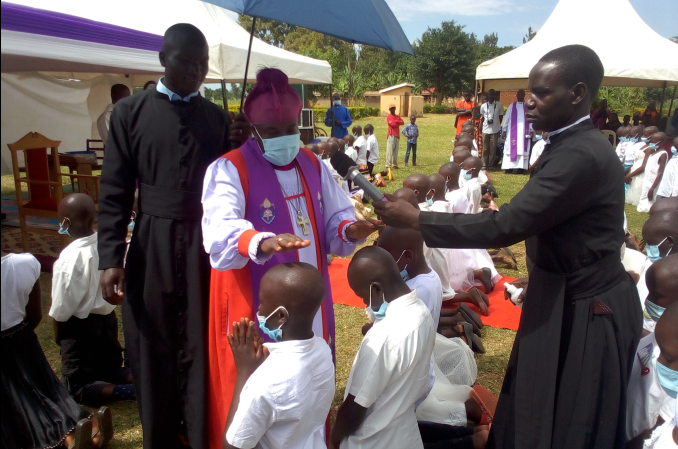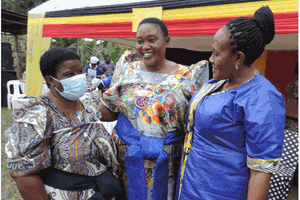
President Museveni addresses a rally at a thanksgiving ceremony for Dr Monica Musenero, the Minister of Science, Technology, and Innovation, held at Petete Primary School in Butebo District in Bukedi sub region recently. PHOTO/ FILE
The 2024 census puts Bukedi Sub-region’s population at 2,376,744, with women (1,206,825) outnumbering men (1,169,919). Tororo (609,117), Busia (412,018), Pallisa (330,961), and Butaleja (312,713) are the most populated districts in the sub-region. Other districts include Budaka (281,106), Kibuku (259,540) and Butebo (171,289).
With about 88.3 percent of households in the sub-region relying on subsistence farming, poverty in Bukedi is only bettered by what is witnessed in Karamoja. Government statistics show that Bukedi’s per capita income stands at 43.7 percent, with a GDP per capita of $135 (about Shs492,583). This is significantly lower than the national GDP per capita of $1,185 (about Shs4,323,781). Bukedi’s poverty rate is 37 percent while the national poverty index currently is 35 percent.
On August 22, President Museveni launched the first Bukedi development strategy plan. Intended to alleviate household poverty in the sub-region, the plan will look to impress upon households the benefits of warming up to cash crops such as coffee, sustainable production methods like nutrient recycling, environmental conservation and irrigation. The aim is to have at least 75 percent of households commercially engaged in the cocoa, poultry, and coffee value chains by 2040.
Masterplan?
The plan set to span 16 years will be at a tune of Shs657.36 billion. The first phase set to run from 2024 to 2030 will need Shs177 billion. The second phase from 2031 to 2036 will take up Shs352 billion. Shs128.36 billion has been earmarked for the third phase from 2036 to 2040. Speaking back in August, President Museveni urged the sub-region to consider local production of cassava starch to stop Uganda’s pharmaceutical sector from looking outward for an ingredient “which is essential for medicine manufacturing.”
The President, who officially inaugurated Lukonge Cotton Company Limited, a company dedicated to cassava starch production, said many local farmers are mismanaging their land, particularly in the valleys where rice cultivation is prevalent. Mr Museveni called on residents in the sub-region to fully utilise their land to achieve greater economic prosperity.
“This is a very rich area, you can see how God arranged it,” he remarked,
Mr Moses Kirya, a farmer in Butebo, says President Museveni’s repeated calls to the locals to abandon rice farming is a surface-level observation.
“The problem of poverty is not about rice growing. Our biggest challenge is the market in the sub-region. We have tried mangoes and cassava farming, but still, the market is poor. We are selling a sack of mangoes at Shs5,000 and a basin of cassava at Shs2,000.”
Land fragmentation
President Museveni has always spoken against land fragmentation, saying the habit, which usually happens “whenever the family head dies” is counterproductive. Now a think tank comprising Prof John David Kabasa, Dr James Kisaale, Mr Thomas Okoth Nyalulu, Mr Richard Waya and other leaders in the sub-region is hoping to force locals like Kirya to rethink their plans.
They also want to catapult annual household income from less than Shs10 million to Shs30 million or more by 2040.
The Bukedi population is rapidly expanding, leading to increasingly fragmented arable land and a rising number of landless people.
According to the 2024 census, nearly 2.4 million people occupy its land area of 4,504 square kilometres. This works out to a population density of 528 persons per square kilometre. The sub-region also has a non-household population of 8,061.
“The communities lack reliable cash crops and have limited access to affordable, nutritious food. Traditional staples like groundnuts and beans, which take three to four months to harvest, require a significant amount of wood for cooking—a resource that is becoming scarce,” says Dr Monica Musenero, the Science, Technology and Innovation minister, who hails from the sub-region.
She adds: “Many youth are landless and spend much of their time idling in trading centres. As a result, household members often suffer from malnutrition, infections, and diseases due to inadequate food and nutrition.
This situation has hindered the communities and the nation from achieving the levels of production and productivity necessary for socio-economic transformation in Bukedi.”

President Museveni (centre), accompanied by Dr Monica Musenero Masanza, the minister for Science, Technology and Innovation (2nd left), during the launch of the first Bukedi Development Strategy Plan on August 22. PHOTO/YAHUDU KITUNZI
Bukedi development has been planned several times nationally. For instance, under the National Development Plan (NDP) III, it was included and earmarked to benefit under the following enterprises: cotton, cassava and rice.
Mr James Wire, an agribusiness consultant, says: “There is need for a tarmac road that traverses from Namutumba, through Butaleja-Mbale where it forks off into two with one arm heading to Nagongera and the other progressing through Doho Rice Scheme [the largest irrigated rice scheme] in the country.”
The agribusiness consultant believes the effect of opening up market access for the numerous farmers engaged in crops such as rice, groundnuts, millet, maize, cassava, watermelon and various vegetables is colossal. Tarmacking the major roads in the sub-region “will act as a stimulant for investment in this Bukedi hinterland that is already a hub for the rice business.”
Mr Wire, who is also the chairperson of the board of Busolwe General Hospital in Butaleja District, says if the road is worked on, it will ease transportation, especially during referrals for ill patients.
Poor road network
The Bukedi Sub-region Strategic Plan provides a robust framework for enhancing household income through development of relevant interventions. The implementation will be aligned to bring the sub-region at par with the rest of the country. With the Parish Development Model (PDM) well and truly underway, leaders and local communities in the sub-region are hopeful that poverty reduction levels will fall below 10 percent by the end of 2025.
The effective execution of this plan will trigger an economic leap of the sub-region from $424.23 million to $8,484.6 million.
Recently, Mr Michael Okongo Choki, the councillor for Mwello in Tororo District, said the cause of under development in the area is poor road network that repels investors.
“The local population can’t find their way to lucrative markets because of the bad roads. The tarmacking of this road will open West Budama to the outside world,” he told Monitor.
Local leaders and residents in the area, say the Lwangoli-Butaleja-Namutumba route and that of Nangongera-Busolwe have been on the government to-do list since 1993.
Ms Harriet Nyakecho, an entrepreneur, says Bukedi is a rich sub-region with poor people.
“Butaleja’s productivity gets poor returns in terms of prices due to poor market access because of bad roads. So tarmac is a big economic and poverty reduction factor for the marginalised district,” she says.
Mr David Mulabi, a former Bunyole East Parliamentary aspirant, says Butaleja, whose population contributes less than 0.5 percent to the national total, produces an estimated 15 percent of national rice output.
“So, it is highly productive, and this produce needs good roads to take to the market for win-win outcomes for the farmers and final consumers,” Mr Mulabi says.
According to a 2017 research by the United States Agency for International Development (USAID), Butaleja’s Gross Domestic Product (GDP) eclipses that of the likes of Bundibugyo, Amolatar, Budaka, Moroto, Kapchorwa, Moyo, Kagadi, Katakwi and others.
Mr Mulabi, who is also a community development expert, says the 2020 poverty maps indicate that Butaleja has the biggest number of poor people and the two poorest sub-counties.
Mr Isaac Kashaija, the chairperson of the Rice Business Sector Association Limited (RBSAL), says farmers were stopped from growing rice in wetlands, a situation that has left many jobless.
“In other countries, they sensitise farmers on how to manage the land instead of evicting them,” he says.
According to Ministry of Water and Environment statistics, Uganda has lost more than 30 percent of its wetlands in the last 23 years.





